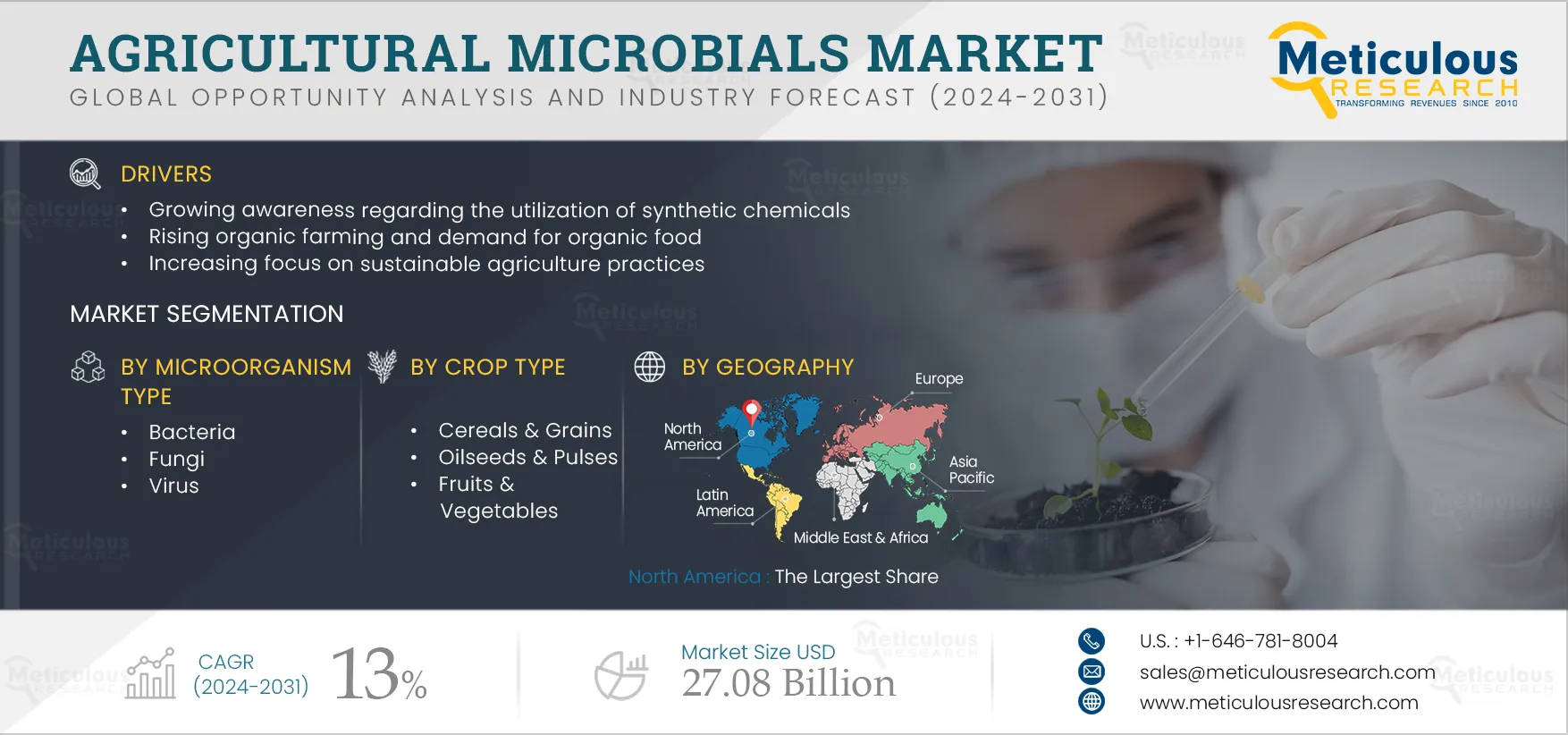The agricultural industry is evolving rapidly, driven by the need for sustainable farming solutions and the increasing demand for organic food. One of the most promising areas of growth within this industry is the agricultural microbials market, which is projected to reach $27.08 billion by 2031, up from $10.31 billion in 2023. With an impressive compound annual growth rate (CAGR) of 13% from 2024 to 2031, agricultural microbials are increasingly being recognized as essential tools in modern farming practices. This blog explores the key factors driving the growth of the agricultural microbials market, the challenges the sector faces, and its future potential.
Download Sample Brochures of Agricultural Microbials Market:- https://www.meticulousresearch.com/download-sample-report/cp_id=5783
What Are Agricultural Microbials?
Agricultural microbials are microorganisms that are used to promote plant health and improve soil quality. They play a vital role in enhancing crop yield, improving soil fertility, and protecting plants from diseases and pests. These beneficial microbes can be broadly classified into bacteria, fungi, viruses, and other types. Agricultural microbials include biofertilizers, biostimulants, and biopesticides, each of which serves a specific function to boost agricultural productivity in an eco-friendly manner.
Factors Driving the Growth of the Agricultural Microbials Market
Several key factors contribute to the rapid growth of the agricultural microbials market:
1. Increasing Awareness About Synthetic Chemicals
Traditional agricultural practices heavily rely on synthetic chemicals such as fertilizers, pesticides, and herbicides. However, the harmful impact of these chemicals on human health and the environment has led to growing concerns among consumers and environmental organizations. There is a rising demand for chemical-free produce, which is creating significant growth opportunities for agricultural microbials. These bio-based solutions help reduce dependency on harmful chemicals, leading to healthier food and a cleaner environment.
2. Rising Demand for Organic Food
The global shift towards organic farming is a major driver of the agricultural microbials market. Organic farming practices avoid the use of synthetic chemicals, favoring natural inputs such as agricultural microbials. The global organic food market is growing rapidly, with sales reaching USD 147.9 billion in 2021, up from USD 97 billion in 2017. This surge in demand is driven by consumers’ increasing health and environmental consciousness. As the demand for organic food rises, the use of agricultural microbials, such as biofertilizers and biopesticides, becomes more critical to ensure that organic crops are healthy and resilient.
3. Sustainable Agricultural Practices
As the world’s population grows, reaching an estimated 9.7 billion by 2050, the pressure to produce more food from the same amount of land increases. At the same time, concerns about environmental sustainability are rising. Agricultural microbials are playing a crucial role in sustainable farming practices by improving soil health, promoting nutrient cycling, and reducing the need for chemical fertilizers and pesticides. These practices help farmers maximize crop yield while minimizing their environmental footprint.
4. Support from Government Initiatives
Governments across the globe are increasingly recognizing the importance of sustainable farming and are offering incentives to promote organic and eco-friendly agricultural practices. Various organizations, such as the U.S. Department of Agriculture (USDA), are encouraging the use of agricultural microbials through research funding and support for organic farming initiatives. This backing is driving the growth of the agricultural microbials market by creating a favorable environment for the adoption of these products.
Have Specific Research Needs? Request a Customized Research Report –https://www.meticulousresearch.com/request-customization/cp_id=5783
Challenges Hindering Market Growth
While the agricultural microbials market shows immense potential, there are several challenges that may hinder its growth:
1. Lack of Awareness Among Farmers
One of the main obstacles to the widespread adoption of agricultural microbials is the lack of education and awareness among farmers, particularly in developing regions. Many farmers are unfamiliar with the benefits of agricultural microbials and may be hesitant to adopt them due to a lack of understanding or previous experience. Education campaigns and training programs will be crucial in overcoming this barrier and ensuring that farmers are equipped with the knowledge to implement these sustainable practices.
2. High Production Costs
The production of agricultural microbials is more costly compared to conventional synthetic fertilizers and pesticides. This can make them less attractive to farmers, particularly in developing countries where cost efficiency is a major factor in farming decisions. Although the cost of production is expected to decrease as the market grows and economies of scale are achieved, it remains a significant barrier to wider adoption in the short term.
3. Shorter Shelf Life and Product Approval Process
Agricultural microbials, especially liquid formulations, tend to have a shorter shelf life compared to synthetic chemicals. This limits their storage and transportation capabilities. Additionally, the lengthy registration and approval processes required for microbial products can delay their availability in the market, further hindering the growth of the agricultural microbials market.
Opportunities in Emerging Economies
Emerging economies, particularly in Asia-Pacific, offer significant opportunities for growth in the agricultural microbials market. As populations in these regions grow and agricultural land faces increasing pressure, farmers are turning to sustainable farming practices, including the use of agricultural microbials. The demand for organic food is also rising, spurred by an increasing awareness of the health benefits associated with chemical-free produce. As a result, the agricultural microbials market is expected to experience rapid growth in these regions during the forecast period.
Immediate Delivery Available | BUY THIS RESEARCH REPORT (Insights, Charts, Tables, Figures and More) – https://www.meticulousresearch.com/request-sample-report/cp_id=5783
Key Segments Driving the Agricultural Microbials Market
The agricultural microbials market is diverse, with various segments contributing to its growth. Some of the key segments include:
1. Microorganism Type: Bacteria Leading the Market
Bacteria are expected to dominate the agricultural microbials market in 2024, with the largest market share. Bacteria-based solutions are commonly used in biofertilizers, biopesticides, and biostimulants, and they are known for their ability to enhance plant growth and protect against root-fungus diseases. Additionally, bacteria play a crucial role in soil health by promoting nutrient cycling and improving soil structure.
2. Product Functionality: Soil Amendments Gaining Traction
While crop protection products currently dominate the agricultural microbials market, the soil amendments segment is expected to experience significant growth over the forecast period. Agricultural microbials are increasingly being used to enhance soil fertility and structure, which is essential for sustainable farming practices. The ability of agricultural microbials to improve soil health is one of the primary drivers of this segment’s growth.
3. Formulation: Liquid Products Leading the Way
In terms of formulation, the liquid segment is expected to lead the market in 2024. Liquid agricultural microbials offer better performance and a longer effective duration compared to dry formulations. They also do not require mixing, which reduces the risk of spoilage and ensures ease of use for farmers.
4. Application Mode: Foliar Spray Dominating the Market
The foliar spray segment is expected to dominate the agricultural microbials market in 2024. Foliar spray is known for its high efficiency and uniform distribution of microbials on plant surfaces. It also provides a fast-acting solution to correct nutrient deficiencies and treat plant diseases.
5. Crop Type: Cereals and Grains Leading the Charge
Cereals and grains are expected to account for the largest share of the agricultural microbials market in 2024. This is due to the increasing demand for these crops, which are essential for food security, animal feed, and biofuel production. Agricultural microbials are used to improve the yield and quality of cereals and grains, making them an important segment of the market.
Regional Outlook: North America and Asia-Pacific
In 2024, North America is expected to dominate the agricultural microbials market, driven by high adoption rates among farmers and strong government support for sustainable farming practices. However, Asia-Pacific is projected to experience the highest growth rate during the forecast period, as increasing population and environmental concerns push farmers toward organic farming practices and the use of agricultural microbials.
Quick Buy @ https://www.meticulousresearch.com/Checkout/40699595
Agricultural Microbials Market Report Summary:
| Particulars | Details |
| Number of Pages | ~700 |
| Format | |
| Forecast Period | 2024–2031 |
| Base Year | 2023 |
| CAGR | 13% |
| Estimated Market Size | Value (USD Million), Volume (Tons) |
| Segments Covered | By Microorganism Type
By Product Functionality
By Formulation
By Mode of Application
By Crop Type
|
| Countries Covered | North America (U.S., Canada), Europe (Germany, France, U.K., Italy, Spain, and Rest of Europe), Asia-Pacific (China, India, Japan, Australia, and Rest of Asia-Pacific), Latin America (Brazil, Mexico, Argentina, and Rest of Latin America), and the Middle East & Africa |
| Key Companies | Syngenta AG (A Part of China National Chemical Corporation/Chemchina) (Switzerland), BASF SE (Germany), Bayer AG (Germany), Corteva, Inc. (U.S.), UPL Limited (India), FMC Corporation (U.S.), Novozymes A/S (Denmark), Nufarm Limited (Australia), Sumitomo Chemical Co., Ltd. (Japan), Koppert B.V. (Netherlands), Pro Farm Group Inc. (U.S.), Isagro S.p.A. (Italy), BioWorks, Inc. (U.S.), Certis USA L.L.C. (U.S.), and Biobest Group NV (Belgium). |
Related Reports:
About Us:
We are a trusted research partner for leading businesses worldwide, empowering Fortune 500 organizations and emerging enterprises with actionable market intelligence tailored to drive revenue transformation and strategic growth. Our insights reveal forward-looking revenue opportunities, providing our clients with a competitive edge through a diverse suite of research solutions—syndicated reports, custom research, and direct analyst engagement.
Each year, we conduct over 300 syndicated studies and manage 60+ consulting engagements across eight key industry sectors and 20+ geographic markets. With a focus on solving the complex challenges facing global business leaders, our research enables informed decision-making that propels sustainable growth and operational excellence. We are dedicated to delivering high-impact solutions that transform business performance and fuel innovation in the competitive global marketplace.
Contact Us:
Meticulous Market Research Pvt. Ltd.
1267 Willis St, Ste 200 Redding,
California, 96001, U.S.
Email– sales@meticulousresearch.com
USA: +1-646-781-8004
Europe: +44-203-868-8738
APAC: +91 744-7780008
Visit Our Website: https://www.meticulousresearch.com/
For Latest Update Follow Us:
LinkedIn– https://www.linkedin.com/company/meticulous-research
Meticulous Blog | Top Market Research Reports Blog – https://meticulousblog.org/







